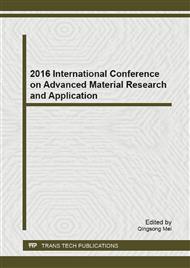[1]
Swamy RN, Tanikawa S. An external surface coating to protect concrete and steel from aggressive environments. Mater. Struct. 1993; 26(8): 465–478.
DOI: 10.1007/bf02472806
Google Scholar
[2]
Aguiar JB, Camoes A, MoreiraPM. Coatings for concrete protection against aggressive environments. J. Adv. Concr. Technol. 2008; 6(1): 243–250.
Google Scholar
[3]
Barbucci A, Delucchi M, CerisolaG. Organic coatings for concrete protection: liquid water and water vapour permeabilities. Prog. Org. Coat. 1997; 30(4): 293– 297.
DOI: 10.1016/s0300-9440(97)00007-6
Google Scholar
[4]
Vries IJ, Polder RB. Hydrophobic treatment of concrete. Constr. Build. Mater. 1997; 11(4): 259–265.
Google Scholar
[5]
Xue X, Yang J, ZhangW, JiangL, QuJ, XuL, Zhang H, Song J, Zhang R, Li Y, Qin J, Zhang Z. The study of an energy efficient cool white roof coating based on styrene acrylate copolymer and cement – Part I: optical properties, estimated cooling effect and relevant properties after dirt and accelerated exposures. Constr. Build. Mater. 2015; 98: 176-184.
DOI: 10.1016/j.conbuildmat.2015.08.045
Google Scholar
[6]
Dai J, Akira Y, Wittmann FH, Yokota H, Zhang P. Water repellent surface impregnation for extension of service life of reinforced concrete structures in marine environments: the role of cracks. Cement Concr. Compos. 2010; 32(2): 101–109.
DOI: 10.1016/j.cemconcomp.2009.11.001
Google Scholar
[7]
Xue X, Yang J, Zhang W, Jiang L, Qu J, Xu L, Zhang H, Song J, Zhang R, Li Y, Qin J, Zhang Z. The study of an energy efficient cool white roof coating based on styrene acrylate copolymer and cement – Part II: mechanical and water impermeability properties. Constr. Build. Mater. 2015; 96: 666-672.
DOI: 10.1016/j.conbuildmat.2015.08.033
Google Scholar
[8]
Jiang L, Xue X, Zhang W, Yang J, Zhang H, Li Y, Zhang R, Zhang Z, Xu L, Qu J, Song J, QinJ. The investigations of factors affecting the water impermeability of inorganic sodium silicate-based concrete sealers. Constr. Build. Mater. 2015; 93: 729-736.
DOI: 10.1016/j.conbuildmat.2015.06.001
Google Scholar
[9]
Song Z, Xue X, Li Y, Yang J, He Z, Shen S, Jiang L, Zhang W, Xu L, Zhang H, Qu J, Ji W, Zhang T, Huo L, Wang B, Lin X, Zhang N. Experimental exploration of the waterproofing mechanism of inorganic sodium silicate-based concrete sealers. Constr. Build. Matter. 2016; 104: 276-283.
DOI: 10.1016/j.conbuildmat.2015.12.069
Google Scholar
[10]
Schulze J, Killermann O. Long-term performance of redispersible powders in mortars. Cem. Concr. Res. 2001; 31(3): 357-362.
DOI: 10.1016/s0008-8846(00)00498-1
Google Scholar
[11]
Saija LM. Waterproofing of Portland cement mortars with a specially designed polyacrylic latex. Cem. Concr. Res. 1995; 25(3): 503-509.
DOI: 10.1016/0008-8846(95)00039-f
Google Scholar
[12]
Rottstegge J, Arnold M, Herschke L, Glasser G, Wilhelm M, Spiess HW, Hergeth WD. Solid state NMR and LVSEM studies on the hardening of latex modified tile mortar systems. Cem. Concr. Res. 2005; 35(12): 2233-2243.
DOI: 10.1016/j.cemconres.2004.10.003
Google Scholar
[13]
Liu S, Hu Q, Zhao F, Chu X. Utilization of steel slag, iron tailings and fly ash as aggregates to prepare a polymer-modified waterproof mortar with a core–shell styrene–acrylic copolymer as the modifier. Constr. Build. Mater. 2014; 72: 15-22.
DOI: 10.1016/j.conbuildmat.2014.09.016
Google Scholar
[14]
Sakai E, Sujita J. Composite mechanism of polymer modified cement. Cem. Concr. Res. 1995; 25(1): 127-135.
Google Scholar
[15]
Al-Zahrani MM, Maslehuddin M, Al-Dulaijian SU, Ibrahim M. Mechanical properties and durability characteristics of polymer- and cement-based repair materials. Cem. Concr. Compos. 2003; 25(4): 527-537.
DOI: 10.1016/s0958-9465(02)00092-6
Google Scholar
[16]
Wu K, Zhang D, Song J. Properties of polymer-modified cement mortar using pre-enveloping method. Cem. Concr. Res. 2002; 32(3): 425-429.
DOI: 10.1016/s0008-8846(01)00697-4
Google Scholar
[17]
Nepomuceno AA, Andrade C. Steel protection capacity of polymeric based cement mortars against chloride and carbonation attacks studied using electrochemical polarization resistance. Cem. Concr. Compos. 2006; 28(8): 716-721.
DOI: 10.1016/j.cemconcomp.2006.05.011
Google Scholar
[18]
Aggarwal LK, Thapliyal PC, Karade SR. Properties of polymer-modified mortars using epoxy and acrylic emulsions. Constr. Build. Mater. 2007; 21(2): 379-383.
DOI: 10.1016/j.conbuildmat.2005.08.007
Google Scholar
[19]
Reis JML. Mechanical characterization of polymer mortars exposed to degradation solutions. Constr. Build. Mater. 2009; 23(11): 3328-3331.
DOI: 10.1016/j.conbuildmat.2009.06.047
Google Scholar
[20]
Medeiros MHF, Helene P, Selmo S. Influence of EVA and acrylate polymers on some mechanical properties of cementitious repair mortars. Constr. Build. Mater. 2009; 23(7): 2517-2533.
DOI: 10.1016/j.conbuildmat.2009.02.021
Google Scholar
[21]
Do J, Soh Y. Performance of polymer-modified self-leveling mortars with high polymer–cement ratio for floor finishing. Cem. Concr. Res. 2003; 33(10): 1497–505.
DOI: 10.1016/s0008-8846(02)01057-8
Google Scholar
[22]
Ramli M, Tabassi AA, Hoe KW. Porosity, pore structure and water absorption of polymer-modified mortars: An experimental study under different curing conditions. Composites: Part B 2013; 55(9): 221-233.
DOI: 10.1016/j.compositesb.2013.06.022
Google Scholar
[23]
Sakai E, Sujita J. Composite mechanism of polymer modified cement. Cem. Concr. Res. 1995; 25(1): 127-135.
Google Scholar
[24]
Schulze J. Influence of water-cement ratio and cement content on the properties of polymer-modified mortars. Ces. Concr. Res. 1999; 29(6): 909-915.
DOI: 10.1016/s0008-8846(99)00060-5
Google Scholar
[25]
Diamanti MV, Brenna A, Bolzoni F, Berra M, Pastore T, Ormellese M. Effect of polymer modified cementitious coatings on water and chloride permeability in concrete. Constr. Build. Mater. 2013; 49(6): 720–728.
DOI: 10.1016/j.conbuildmat.2013.08.050
Google Scholar
[26]
Ramli M, Tabassi AA. Effects of polymer modification on the permeability of cement mortars under different curing conditions: A correlational study that includes pore distributions, water absorption and compressive strength. Constr. Build. Mater. 2012; 28(1): 561-570.
DOI: 10.1016/j.conbuildmat.2011.09.004
Google Scholar
[27]
Almeida AEF, Sichieri EP. Mineralogical study of polymer modified mortar with silica fume. Constr. Build. Mater. 2006; 20(10): 882-887.
DOI: 10.1016/j.conbuildmat.2005.06.029
Google Scholar
[28]
Kuhlmann LA. Latex-modified concrete for repair and rehabilitation of bridges. Int. J. Cement Composites & Lightweight Concrete 1985; 7(85): 241-247.
DOI: 10.1016/0262-5075(85)90044-2
Google Scholar
[29]
Nirmala J, Dhanalakshmi G. Influence of nano materials in the distressed retaining structure for crack filling. Constr. Build. Mater. 2015; 88: 225-231.
DOI: 10.1016/j.conbuildmat.2015.04.022
Google Scholar
[30]
Hamzaoui R, Guessasma S, Mecheri B, Eshtiaghi AM, Bennabi A. Microstructure and mechanical performance of modified mortar usinghempfibres and carbon nanotubes. Mater. Des. 2014; 56(4): 60-68.
DOI: 10.1016/j.matdes.2013.10.084
Google Scholar


